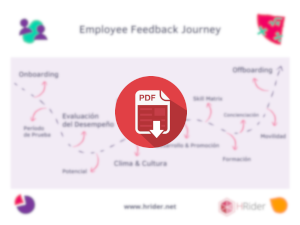Employee Feedback Journey
What is the Employee Feedback Journey?
It consists of identifying the key moments during an employee's period -Employee Journey- in which it is important to encourage feedback. It is a concept coined by Hrider experts.
Such a plan may include initiatives such as performance evaluations or employee satisfaction surveys. Meetings between managers and employees and team-building events are also essential; generally speaking, anything that encourages active employee engagement in the company is advisable.
Additionally, a Feedback Plan should incorporate dates for launching these initiatives. The tone, pace, and frequency with which we promote each action will also impact the culture we promote.
Key Moments in the Employee Feedback Journey
1. Onboarding: Evaluates a new employee’s integration process. Includes aspects such as training, understanding company policies and processes, cultural adaptation, etc.
2. Probation Period: Measures performance during the probation period. This helps detect whether the employee is suitable for the job and adapts to the company’s culture.
3. Performance Evaluation: Measures individual performance and contribution to the organization.
4. Potential: Identifies employees' competencies and potential for assuming greater responsibility and leadership roles within the company. Detecting and developing employees' potential can lead to better individual and company performance
5. 360º Feedback: Comprehensive and detailed evaluationof an employee's performance. Feedback is collected from all roles that interact with the evaluated person. This helps identify areas for improvement, strengths, and develop action plans.
6. Climate and Culture: Allows us to understand the atmosphere and work dynamics within the company. We can evaluate aspects such as communication, employee satisfaction, ethics, or team cohesion.
7. Skills Matrix: Helps identify employees’ competencies and how developed they are, so they can benefit and contribute to the company.
8. Development and Promotion: By crossing performance and potential data through the use of the9-BOX, we can identify those who need further training to qualify for promotion.
9. Training: Identifies opportunities for improvement in training processes to ensure they are aligned with the organization's objectives and employees' needs. It also allows employees to suggest areas for training.
10. Psychosocial risk assessment: evaluating psychosocial risk factors provides the necessary clarity to identify areas for improvement, optimize the work environment, and protect your team. Invest in a healthier and more efficient work future.
11. Awareness: Allows launching awareness evaluations on any subject affecting the company. For example, on digital security or occupational risk prevention.
12. Mobility: Identifies development and promotion opportunities in different locations and helps foster labor mobility.
13. Offboarding: Helps identify areas for improvement in previous processes and, consequently, reduces turnover.
Download our Employee Feedback Journey Template.
Employee Journey Map: what it is, why you need it and how to create it
An employee journey is an interactive process that helps employees understand their roles within the organization. It also helps organizations and the team to identify what kind of employee they are looking for. Find out how to create your own employee journey map. It includes a free template.

